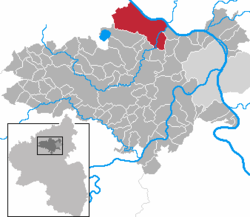Our website is made possible by displaying online advertisements to our visitors.
Please consider supporting us by disabling your ad blocker.
Andernach
Andernach | |
|---|---|
 | |
| Coordinates: 50°26′23″N 7°24′06″E / 50.43972°N 7.40167°E | |
| Country | Germany |
| State | Rhineland-Palatinate |
| District | Mayen-Koblenz |
| Government | |
| • Lord mayor (2022–30) | Christian Greiner[1] |
| Area | |
• Total | 53.23 km2 (20.55 sq mi) |
| Elevation | 60 m (200 ft) |
| Population (2022-12-31)[2] | |
• Total | 30,277 |
| • Density | 570/km2 (1,500/sq mi) |
| Time zone | UTC+01:00 (CET) |
| • Summer (DST) | UTC+02:00 (CEST) |
| Postal codes | 56626 |
| Dialling codes | 02632 |
| Vehicle registration | MYK |
| Website | www.andernach.de |
Andernach (German pronunciation: [ˈandɐˌnax] ⓘ) is a town in the district of Mayen-Koblenz, in Rhineland-Palatinate, Germany, of about 30,000 inhabitants. It is situated towards the end of the Neuwied basin on the left bank of the Rhine between the former tiny fishing village of Fornich in the north and the mouth of the small river Nette in the southeast, just 13 miles (21 km) north of Koblenz, with its five external town districts: Kell, Miesenheim, Eich, Namedy, and Bad Tönisstein.
A few hundred metres downstream of Andernach the Rhine valley narrows from both sides forming the northern part of the romantic Middle Rhine stretch. Already in Roman times the place the narrow passage begins was named "Porta Antunnacensis" or Andernachian Gate. It is formed by two hills, the Krahnenberg (engl. Crane hill) and the Engwetter (Narrow weather) on the right bank near the wine village Leutesdorf (external town district of Bad Hönningen). The crane hill is named after the old crane beneath his foot (see below); in earlier times (until 1650) the hill was named "Geiersberg" ("Vulture's hill").
After World War II it was the site of two Rheinwiesenlager temporary prison camps.
- ^ Wahlen der Bürgermeister der verbandsfreien Gemeinden, Landeswahlleiter Rheinland-Pfalz. Retrieved 5 June 2023.
- ^ "Bevölkerungsstand 2022, Kreise, Gemeinden, Verbandsgemeinden" (PDF) (in German). Statistisches Landesamt Rheinland-Pfalz. 2023.
Previous Page Next Page






